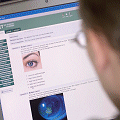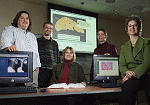2007 Campus Technology Innovators: Online Education

TECHNOLOGY AREA: ONLINE EDUCATION
Innovator: University of Vermont College of Medicine
An online environment for everyone: students,
teachers, and more
The University of Vermont College of Medicine might be
the nation's seventh oldest medical school, but educators and
administrators there took a massive technological leap when
they implemented a new, integrated curriculum in 2003. The initiative
called for an integrated approach to education that incorporated
online and offline instruction. Where other medical
schools had sought depth in multimedia or simulation, Vermont
strove for ubiquity in all aspects of the online educational experience:
every course, clinical site, lecture, and exam.

Dubbed the College of Medicine Education Tools, or COMET,
the new tech initiative was a Herculean undertaking; an implementation
that began in 2002 with the installation of Blackboard
6 and a content management system.
Technologists designed the system so that it could support up
to 120 teaching faculty per course, and so that enrollments
could flow from the college's student information and human
resources systems. All faculty members now have access to all
courses, and exams pull items from the entire curriculum.
In order to facilitate secure access to course materials
and exams, College of Medicine officials incorporated technology
products from other vendors that work seamlessly with the
Blackboard interface. Two of these—Securexam from Software
Secure and the suite from Learning Objects—fit this bill.
With help from Competitive Computing (a strategic tech consulting
firm serving public and private sector organizations in
the Northeast), the school was able to
tie everything together neatly and unobtrusively for the users.
"Our advice would be to not let the technology get in the
way of the teaching or learning," says Jill Jemison, the college's
instructional technology director. "The best technology
choice is the one that integrates most seamlessly into the culture
of your institution, not into the infrastructure."
Since the launch, benefits of the system have been many.COMET has brought technology to the fingertips of busy clinical
and research faculty and created an electronic connection
between rural community doctors and the college's academic
medical center. Students also have been pleased to engage
in the learning process online. Today they can refer to previous
material for review, and use online collaboration tools to
hold virtual study sessions. What's more, all exams now contain
color images, video, and sound—all of which moves students
closer to real-life medical experience.

UVCM'S COMET TEAM
strove for ubiquity in the
entire online educational
experience: every course,
clinical site, lecture,
and exam.
Of course, innovation does not come without hiccups. The
first time the college used COMET to deliver high-stakes
exams to both classes, everything crashed: As the first-year
students were finishing their exams, the second-year students
were studying for theirs, and overloaded the system. As a
result of the crash, some first-year students lost their exams;
administrators panicked and offered the second-year students
paper tests. Surprisingly, the students refused. "We'll wait,"
they said. "They trusted the technology," Jemison notes.
Moving forward, the college's next steps include expanding
COMET to further deepen the student experience. Officials
have piloted podcasts and course-based wikis this year, and
will implement them across the curriculum next year. The college
also will increase the system's integration with library
resources to benefit both students and community faculty members.
Finally, IT leaders will study how this year's graduating
class uses COMET as residents, and how the system works to
support lifelong learning via the addition of ePortfolios.